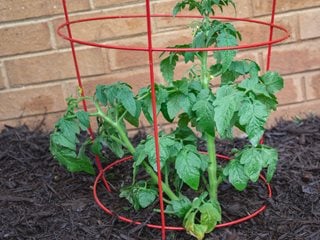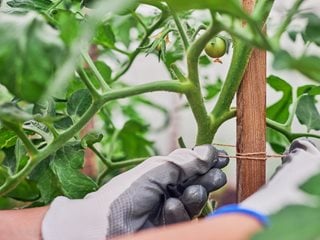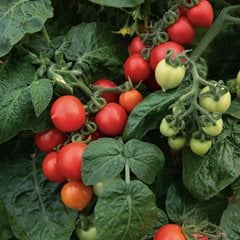Staking Tomatoes: A Simple How-To Guide
Whether you’re growing in pots or have multiple rows of tomatoes, discover four simple steps for staking your tomato plants Reviewed by Denise Kelly, Horticulturist
Staking tomatoes saves space and makes pruning and harvesting easier.
Did you know that about 35% of American families grow some of their own fruits and veggies at home? They can enjoy the benefit of fresh, organic crops that have a rich and delicious flavor.
One type of plant many people grow is tomatoes. Tomatoes are delicious fruits that taste great in salads, on pizza, and in tons of other recipes!
If you're growing your own, you'll need to know how to grow tomatoes from seed as well as stake tomato plants properly. Let's take a look at staking tomatoes in this guide.
WHY YOU SHOULD STAKE TOMATOES
Before we dive into the steps of staking tomatoes, let's talk about why you should stake them:
- Staking your tomatoes keeps them organized and saves tons of space in your garden.
- When you stake your tomatoes, you reduce the risk of them rotting or developing diseases.
- Stakes also make them less accessible to garden pests and insects.
- Staking makes it easier to access all parts of the plant for trimming and harvesting.
STEP ONE: FIGURE OUT WHAT TYPE OF TOMATOES YOU'RE GROWING
The first step to setting up your vegetable garden and staking your tomatoes is to figure out what type of tomatoes you're working with. There are two types of tomatoes you might work with: determinate tomatoes and indeterminate tomatoes.
Let's take a look at what each of these means and how it affects staking a tomato plant.
Determinate tomatoes:
Determinate tomatoes grow to predetermined sizes. They bear all their fruit in about a two-week time period.
Determinate tomatoes don't need as much help when it comes to staking. You'll still want to support them, but the vines on these plants are much smaller, so you can easily grow them in more confined places.
Another factor to keep in mind about determinate tomatoes is that many hybrid varieties are determinate. Check the label on your seeds for your variety.
Indeterminate tomatoes:
Indeterminate tomato plants grow larger and tend to bear heavier fruit over a longer period of time. They usually produce more fruit, too. Which means they’ll benefit from sturdy stakes.
Indeterminate tomatoes keep producing tomatoes all the way up until the first frost. That means you'll get a much larger harvest out of these plants!
What are some varieties of tomatoes that don’t need support?
Bush tomatoes with lightweight fruit, like some cherry or patio tomatoes, can be grown with little or no support. These are a great choice for growing in containers on your patio.
Try growing Tempting Tomatoes® Goodhearted® or Patio Sunshine, neither need to be staked or caged to grow successfully.
STEP TWO: CHOOSE BETWEEN CAGING OR STAKING
There are two methods you can use for staking tomato plants:
- Caging
- Staking
Each method has its benefits and drawbacks and is best suited to a specific type of plant. Here's what to know about these methods.

Photo by: eurobanks / Shutterstock.
Caging tomatoes:
If you're staking determinate tomatoes, it's a good idea to buy a tomato cage. Tomato cages support the plant as it grows and helps lighten your workload.
A good rule of thumb is to place determinate tomatoes in cages while the plants are young. That way, the plant will fill out as it grows and you'll have to tie the tomatoes less often than if you were staking.
Now, while we recommend caging for determinate tomatoes, that's not to say that you can't use cages for indeterminate ones, too. Just keep in mind that you'll need larger cages since the plants grow taller.
Pro Tip: You can make your own tomato cages out of concrete reinforcing wire, livestock wire, or chicken wire. This can be a fun garden activity as well as a great way to protect your plants.
Staking tomatoes:
The other option is classic staking for tomatoes. Staking is much less expensive than caging, but you'll have to carefully tie the vine without damaging it.
When you stake a tomato plant, you'll want to choose stakes that are appropriate for your type of tomato. Indeterminate stakes should be about six to seven feet tall, while determinate stakes can be closer to three feet or so.
Either way, you'll need to make sure the stake is sturdy enough to hold the vine and the fruit. Wooden stakes are an affordable and easy-to-find option. But, there are lots of choices including plastic, steel, and bamboo poles. If one end of the stake is pointed it will be easier to place in the soil.
To stake your tomatoes, push the stake at least a foot into the ground and keep it about five inches away from the growing plant. Then, tie the tomatoes to the stake using a bit of twine, string, or old pantyhose. You'll need to add more ties every 6 to 8 inches as they grow.
STEP THREE: SELECT A STAKING METHOD
Another part of staking your tomato plants involves choosing a staking method. There are three main methods you can use:
- Florida weave
- Single stake
- Double stake
Here's what to know about each method.
Florida weave:
With this method, plant the tomatoes in two rows that are about two feet apart. Then, drive a stake at the start and finish of each row, with stakes between every three plants.
Tie some twine around your first stake and weave it in front of one plant and then behind the other. Do this to the end of the row and then repeat going down the second row.
Note: The Florida weave is for gardeners who grow a lot of tomatoes. If you have a large tomato plot, this might be for you.

Photo by: wertinio / Shutterstock.
Single stake:
With the single stake method, you'll simply stake your plants once they grow to about a foot tall. Tie the stakes to the vine using your chosen tie and re-tie the plants every six inches.
Single stakes tend to be a great choice for potted plants because they don't take up a lot of extra space.
Double stake:
Double staking works well for supporting tomatoes that are heavy, like heirlooms. For this method, place two stakes on opposite sides of the plant. Then, tie the twine or jute around the plant stem and each of the two stakes. Continue tying as your tomatoes grow.
STEP FOUR: PRUNE YOUR PLANTS
The last step for growing and staking tomatoes is to prune away the suckers. Suckers are weak parts of the plant that won't bear fruit. You'll usually find them between fruiting branches and the main stem.
After you’ve staked the fruit-bearing parts of the plant, prune away the suckers so that they don't suck the energy out of the plant. That way, the plant can use all its strength to grow fruit-bearing branches.
What's more, pruning your plants keeps them healthy by allowing for better air circulation. Read more about how to prune tomato plants.
STAKING TOMATOES MADE SIMPLE
With this guide to staking tomatoes, you'll have no problem getting your plants growing beautifully. Just keep these tomato staking tips in mind and pretty soon you'll have delicious homegrown tomatoes.
MORE ON GROWING TOMATOES:
How to Grow Tomato Plants
Types of Tomato Plants
Tomato Diseases & Pests
Why Are My Tomato Plant Leaves Turning Yellow?
Growing Tomatoes in Containers

